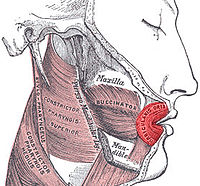
Photo from wikipedia
Abstract Facial nerve injury results in degradation of the neuromuscular junction (NMJ) and blocks neurotransmission between the pre- and postsynaptic structures, which are separated by a synaptic cleft. Matrix metalloproteinases… Click to show full abstract
Abstract Facial nerve injury results in degradation of the neuromuscular junction (NMJ) and blocks neurotransmission between the pre- and postsynaptic structures, which are separated by a synaptic cleft. Matrix metalloproteinases (MMPs), enzymes that degrade and modify the extracellular matrix, play critical roles in regulating NMJ remodeling. We previously demonstrated that MMP1, MMP2, MMP3, MMP7, and MMP9 are overexpressed in facial nerve-innervated orbicularis oris muscle after facial nerve injury in a rat model. In the present study, the MMP inhibitor prinomastat was administered to rats after facial nerve injury. The MMP levels, agrin expression, and muscle-specific kinase (MuSK) phosphorylation were evaluated. Variations in evoked electromyography (EEMG) amplitude were also recorded. Compared with the control group, MMP expression in the orbicularis oris after facial nerve injury was significantly reduced in the prinomastat group. Inhibition of MMP expression maintained agrin expression and MuSK phosphorylation; the NMJ morphology was also protected after the injury. Moreover, prinomastat treatment sustained EEMG amplitude and muscle tension after the injury. These findings indicate that inhibiting MMPs can protect the function and morphology of the NMJ and demonstrate the need for protection of the NMJ at early stages after facial nerve injury.
Journal Title: Journal of Neuropathology and Experimental Neurology
Year Published: 2022
Link to full text (if available)
Share on Social Media: Sign Up to like & get
recommendations!